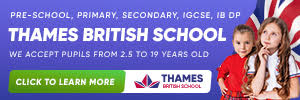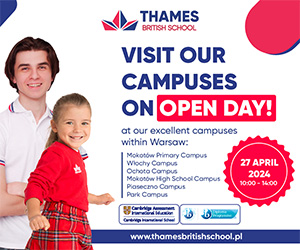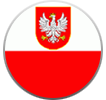On this page:
- Students
- Teachers
- The unique character of the facility
- Balancing knowledge and play
- Language education
- School during the pandemic

Julia Anderko: The school was founded in 1998. It started with the English Playhouse, our preschool. There was only one location back then. The facility has expanded and now we have four different locations. The one where I teach is the only location with Playhouse and English Primary classes. I am the only primary school teacher. In my location, there’s Reception and Year 1. The children I have been teaching for 2 years are currently in Grade 3 and this is the highest class we have.
Students
Our Kids: How old are the youngest students?
Julia Anderko: The youngest children are 12-months-old and are admitted to various locations.
Our Kids: Where do they go when they finish your program?
Julia Anderko: They continue their education in international schools in Warsaw, which either teach according to the British system or follow the American curriculum. It’s possible that next year we’ll have older classes in our school, such as Year 4.
Our Kids: Where do your students come from?
Julia Anderko: Most of the children I teach come from Polish families. But other teachers have a lot of children from international families, e.g., children of diplomats or people who work in Poland on contracts in foreign companies and for whom it’s very important that the children study in institutions that teach in English. For example, last year I had a kid from Mongolia and a girl from the US. I also have children from mixed marriages where one of the parents speaks Polish and the other, for example, Russian or Danish. In total, about 60 percent of our students are international, and the rest are from Polish families who want their kids to learn English from an early age because it is beneficial for them and opens many doors.
In my opinion, it’s a great mix because children learn quickly from each other. Besides, it’s excellent, because they learn about other cultures. Our program includes a lot of games and activities related to different cultures. We have a large group of children from China, so we organize the Chinese New Year. Parents also love to participate in it. Just before the coronavirus pandemic, we organized this year's Chinese New Year—many parents came, and our Chinese families brought wonderful traditional food and they showed us, for example, how to write Chinese characters. Children can learn a lot this way. I don't think such classes are organized in a typical Polish public school.
Our Kids: So some of the families come to Poland for a few years and then leave?
Julia Anderko: Yes, this is the case, for example, with children of people working in embassies—parents either go to work in another country or return to their home country. So unfortunately some of our children leave...
Teachers
Our Kids: And who teaches in your school?
Julia Anderko: Most of our teachers are Poles, both the main teachers and their assistants. All of them have a very good command of English and some have lots of teaching experience. We also have teachers from abroad—Americans and Brits.
The unique character of the facility
Our Kids: What makes your school unique?
Julia Anderko: The special thing is that it’s a family environment. “My children,” the children in my group, have been together since they were 2-years-old and are now 8. It's a long time. Parents love our school, children also love coming to school—they’re all close friends and spend a lot of time together, also outside of school. We’re like a big family. The teachers have also been working together for a long time and are very close to each other.
Another very important thing in our school is very practical—kinesthetics is the basis of our pedagogical activities. This is very important for the development of children. Many scientific studies show this is beneficial for all types of learners, regardless of whether the child is visual or learns better by hearing. All children respond excellently to practical, kinesthetic teaching where they can touch everything and engage in hands-on learning.
Our Kids: How does it work in practice?
Julia Anderko: We do a lot of scientific experiments, we go on trips, there are music lessons once a week, and of course the children have classes in the gym. There are a lot of art classes. It’s a pity everything is now restricted by the pandemic because we were planning the so-called green school, but due to the pandemic it won’t be possible. It would have been a great experience for them—the first time to spend an entire weekend together, without families. We also have support for children with special needs with our teachers working individually with those who need this type of support. Our school is a very friendly place both for people working there and, above all, for the children.
Balancing knowledge and play
Our Kids: How is knowledge introduced and how is it balanced with play?
Julia Anderko: Let me give you a few examples. For example, last year “my children” learned about different types of matter: solids, liquids, and gases, and we did this through a project where they made their own ice cream by mixing salt with ice. We had lessons about Spain and the culture of this country—our principal brought a flamenco dress and we made paella together. Children learn without realizing they’re learning because they have fun doing it. This is the best way. Of course, they spend a lot of time outdoors because all our locations have beautiful playgrounds where children play with other kids from other groups, e.g., with their siblings.
We use materials from the Hamilton Trust very often in our work—this is a UK website that has lesson plans in many subjects from the beginning of education until Grade 6. There are many great examples of activities, information about what children should learn in each lesson. Children are extremely curious, they ask a lot of questions, and they’re very alert to facts and information. The Hamilton Trust also provides sources, books, and aids that can be used.
Language education
Our Kids: How do you handle language education?
Julia Anderko: Some children come to us without knowing a word of English, and English is the language we use at school. Many of them start at a very young age and are immersed in the language from day one. From the moment we greet them, we try not to speak Polish, even if the teacher knows the child’s native language. In fact, our children grow up in two languages: they have one language at home—Polish, Chinese, or any other, and have English all the time in school. We play with them in English, we read in English, we sing in English. Young children are like sponges, so they learn a second language very quickly. Even when the books are just pictures, we speak English with them. Then the first words appear in books, also in English.
Children play all day with other children who speak English. This is a gradual process, but the most important thing is that children are immersed in the language all day long. Everywhere on the walls in each classroom there are pictures with English words, posters, and many books in each class. We try to provide children with various language stimuli. This year I had a girl from Denmark who came in February without knowing a word of English, and at the moment she’s doing great. Children are amazing.
Our Kids: Apart from English, do you pay attention to Polish?
Julia Anderko: There is a Polish teacher who has 45-minute Polish lessons four times a week, following the Polish program. It only starts at the Reception level, at the age of 5 to 6.
School during the pandemic
Our Kids: How do you deal with the pandemic?
Julia Anderko: On May 25, we can come back, but this only applies to Grades 1, 2, and 3. In my opinion, and I have heard this from many parents, everyone is impressed with how quickly we managed to organize and start distance learning. After 2 to 3 days, the school started online. We use the Seesaw online platform—it's an American website, highly interactive, which I used while working in the US. It’s very teacher- and student-friendly.
We, as teachers, can provide children with worksheets, insert videos, and children can respond to the teacher and communicate with each other. Everything that the children prepare and want to pass on to us, teachers, goes through this program. We also read with children, but we do it through Zoom. We use cameras, so we can see the children, and we do it twice a day.
I consider it the greatest success that everything we did with children before the pandemic is also happening today. So the children have music lessons once a week, and as before, they still have individual tutorials. We still read with children four times a week, there are also speech therapy sessions, as well as technical education and PE classes.
Our Kids: How many hours of activities per day do you offer to children?
Julia Anderko: I sit down at my computer at 8:30 a.m. and teach until 3:30 p.m. We have two 45-minute lessons, and I have reading sessions twice a week. Children also speak Polish four times a week. I only have 10 children in my class now. There is also a teacher supporting me—my assistant.
Our Kids: What about the youngest children? Do they also have online classes?
Julia Anderko: Even young children meet and see their teachers. Of course, to be able to see teachers on their iPads or computers, they must be under their parents’ care. But the idea is to arrange the time for the teachers to tell them stories, and it’s very important not only that they see the teacher, but that they see each other as well. Obviously, such young children can’t concentrate for very long and can’t sit in front of the computer for 45 minutes, but they have time when they can hear their teacher's voice and see her face. Sessions for this age group last approximately 15 to 20 minutes.
Distance learning is difficult when you only have virtual contact with your children. Of course, it’s also a challenge for parents because they have to prepare and supervise everything. However, I’m very impressed because “my children” have become very independent. They’re able to upload something they prepared online, sit during lessons, listen, and control what’s urgent. I must say the children surprised me with their responsibility and independence. It will be a very valuable lesson for them in the future.
People who read this also viewed:
- Private primary schools in Warsaw
- Private & non-public primary schools
- Social primary schools
- Private bilingual elementary schools in Warsaw
- Poland education: grade levels
- Our Kids Interview: Get to know FSA School
- Our Kids Interview: Get to know Polish British Academy of Warsaw
- Private schools Warsaw
- Private day schools in Warsaw
- International schools in Warsaw
- Boarding schools in Warsaw
- Montessori schools in Warsaw
- Private high schools in Warsaw
- Private primary schools in Warsaw
- Preschools in Warsaw
- Non-public schools in Warsaw
- Private language schools in Warsaw
- Types of schools in Warsaw
- Private Catholic and Christian schools in Warsaw
- International Baccalaureate (IB) schools in Warsaw
- Warsaw preschool costs
- Private special needs schools in Warsaw
- Our Kids Interview: Get to know Thames British School
- Our Kids Interview: Get to know PRIMUS Non-Public Primary School No. 47 and Non-Public Secondary School
- Our Kids Interview: Get to know Polish British Academy of Warsaw
- Our Kids Interview: Get to know the Canadian School of Warsaw
- Our Kids Interview: Get to know The Primary and Secondary Schools of the Sisters of Nazareth in Warsaw
- Mokotow High School Campus - a new Warsaw high school and Thames British School campus
-
Advice Guide
- ABC of educational terminology: Glossary of terms and concepts
- The admissions process
- Advantages and disadvantages of studying in an international school
- The application process
- Benefits of Polish private schools
- Bilingual schools
- Boarding schools
- Choosing a private or nonpublic school in Poland
- Compare schools in Poland
- English schools in Warsaw
- Homeschooling
- International schools in Kraków
- International schools
- Private school interviews
- Music education
- Myths about private education
- Non-public schools in Poland
- School open houses
- Our Kids Interview: Get to know EF Academy Oxford
- Our Kids Interview: Get to know Open School
- Our Kids interview: Get to know Regent College International Schools
- Our Kids Interview: Get to know The American School of Warsaw
- Our Kids Interview: Get to know The British School Warsaw
- Our Kids Interview: Get to know Wrocław Cosmopolitan School (two interviews, new video)
- Poland school profiles
- Private day schools
- Gifted schools & programs
- Private Jewish schools in Poland
- Language schools
- Private school tuition and costs in Poland
- Private schools in Poland
- Private schools in Poland offering French-language immersion
- English immersion schools
- Poland school uniforms
- Public versus non-public schools in Poland
- Private school questions
- Private school rankings
- Reasons for choosing private schools - Our Kids’s survey report
- Religious schools
- Schools and classes for children with ADHD in Poland
- Social Schools
- Special educational needs (SPE) certificates
- Special needs schools
- Study abroad at a private school
- The first annual non-public school fair in Poland
- The first annual Our Kids non-public school expo in Warsaw was a great success
- Third Private School Expo in Warsaw - summary
- Types of schools
- Types of schools in Warsaw
- Warsaw preschool costs
- Why private school?
- Why parents go private
-
Grades
- Boarding high schools
- Choosing a high school in Poland
- Mokotow High School Campus - a new Warsaw high school and Thames British School campus
- Montessori nursery schools
- Montessori preschools
- Our Kids Interview: Get to know FSA School
- Our Kids Interview: Get to know KIDS & Co.
- Our Kids Interview: Get to know Polish British Academy of Warsaw
- Our Kids Interview: Get to know The English Playhouse and The English Primary
- Poland education: grade levels
- Preschools in Warsaw
- Private & non-public preschools
- Private & non-public primary schools
- Private bilingual elementary schools in Warsaw
- Private high schools
- Private high schools in Warsaw
- Private middle schools
- Nursery schools
- Private primary schools in Warsaw
- Social high schools
- Social primary schools
-
Locations
- Boarding schools in Warsaw
- English schools in Kraków
- International Baccalaureate (IB) schools in Warsaw
- International schools in Warsaw
- Montessori schools in Warsaw
- Non-public schools in Warsaw
- Our Kids Interview: Get to know EF Academy
- Our Kids interview: Get to know Excellence in Education better
- Our Kids Interview: Get to know PRIMUS Non-Public Primary School No. 47 and Non-Public Secondary School
- Our Kids Interview: Get to know the Canadian School of Warsaw
- Our Kids Interview: Get to know The Primary and Secondary Schools of the Sisters of Nazareth in Warsaw
- Private Catholic and Christian schools in Warsaw
- Private day schools in Warsaw
- Private language schools in Warsaw
- Private schools in Bialystok
- Bydgoszcz schools
- Częstochowa schools
- Private schools in Gdańsk & Gdynia
- Katowice schools
- Private schools in Krakow
- Lublin schools
- Olsztyn schools
- Private schools in Poznań
- Private schools in Rzeszów
- Szczecin schools
- Private schools Warsaw
- Private schools in Wrocław
- Zielona Góra schools
- Private schools in Łódź
- Private special needs schools in Warsaw







 POL
POL CAN
CAN